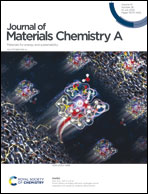A multiscale biomimetic strategy to design strong, tough hydrogels by tuning the self-assembly behavior of cellulose†
Abstract
Strong and tough hydrogels have gained popularity for various applications; however, their fabrication remains challenging, particularly when incorporating functionalities. Here, we describe a novel facile multiscale biomimetic strategy that combines molecular and structural engineering to fabricate strong and tough hydrogels. More specifically, a non-covalent-bonding-driven self-assembled cellulose skeleton is embedded in a polyacrylamide matrix. Water-induced cellulose self-assembly facilitates the production of a biomimetic design. The resulting hydrogel exhibited unique interesting features, including the hierarchical structure of the skin, molecular-scale regulation of the enhanced skeleton, and incorporation of physical interfacial interactions. The resultant hydrogels showed excellent tensile strength, toughness and stretchability, with antibacterial, anti-freezing, and adhesive properties desirable for sensor applications. This study proposes an effective strategy that can be used to overcome the challenge of the mutual exclusivity of high strength and toughness and circumvent the trade-off between functionalities and mechanical properties. Thus, this study provides new insights for designing strong and tough hydrogels.



 Please wait while we load your content...
Please wait while we load your content...